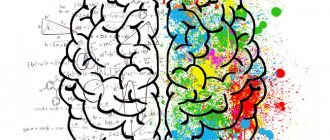Stuttering
Stroke
Encephalitis
5508 March 30
IMPORTANT!
The information in this section cannot be used for self-diagnosis and self-treatment.
In case of pain or other exacerbation of the disease, diagnostic tests should be prescribed only by the attending physician. To make a diagnosis and properly prescribe treatment, you should contact your doctor. Stuttering: causes of occurrence, what diseases it occurs with, diagnosis and treatment methods.
Definition
Oral speech is a complex multicomponent process in which not only the structures of the maxillofacial apparatus, but also the brain centers located in the cerebral cortex take part. It is in these structures that in most cases certain pathological processes leading to the development of stuttering are localized.
Stuttering (stammering) is understood as a speech feature characterized by frequent repetition or prolongation of sounds, syllables or even words in combination with frequent pauses, which disrupts the fluency of oral speech.
Today, different figures are given that characterize the number of people who stutter - from 1 to 5%. However, all experts are unanimous that among males stuttering occurs 4 times more often than among females, and also that in 90-95% of cases stuttering occurs between the ages of 2 and 7 years.
This speech defect often leads to problems in communication, which consist not only in the difficulty of perceiving such speech on the part of the listener, but are also associated with the internal emotional experiences of a stuttering person.
Types of stuttering
There are the following types of stuttering:
- Neurotic stuttering, the development of which is usually based on some psychotraumatic factor. This type of stuttering is psychogenic and is not based on structural damage to the brain or peripheral parts of the speech apparatus.
- Neurosis-like stuttering - unlike neurotic stuttering, it develops against the background of organic damage to the nervous system.
- Mixed stuttering develops against the background of both a psychogenic factor and true damage to the nervous system.
Possible causes of stuttering
Stuttering is based on various muscle spasms of the speech apparatus. They develop due to abnormal impulses emanating from the motor speech centers of the brain. The cause of the pathological functioning of these parts of the central nervous system can be both structural and functional disorders. The latter are characterized by the presence in some part of the brain of a focus of excitation, which activates the motor speech center and leads to the development of convulsive readiness of the muscles involved in articulation and voice formation.
If tonic convulsions develop, a prolonged muscle spasm occurs, resulting in speech delay. Unlike tonic convulsions, clonic convulsions are a series of short-term convulsions that lead to involuntary repetition of sounds or syllables.
Both types of seizures lead to impaired speech fluency and stuttering.
Diseases that cause stuttering
Among the factors influencing the development of stuttering, doctors identify the following diseases and conditions:
- emotional lability and dysfunction of the autonomic nervous system;
- mental trauma;
- traumatic brain injuries;
- infectious brain damage;
- stroke;
- perinatal damage to the central nervous system of the child, associated, as a rule, with a violation of the supply of oxygen to brain structures in the prenatal period of development, during childbirth and in the first hours and days of life.
Which doctors should I contact if I stutter?
Traditionally, the initial examination of a patient with stuttering is carried out. After a detailed interview with the patient, the purpose of which is to clarify the circumstances of the appearance of stuttering and possible provoking factors, the doctor specifically examines the nervous system for the presence of other signs of neurological abnormalities. In the treatment of stuttering, doctors resort to the help of a speech therapist and psychologist. Often, to treat stuttering, especially in the absence of organic damage to the nervous system, the neurologist refers the patient to a consultation with a psychiatrist in order to identify some mental abnormalities that lead to the development of stuttering.
Diagnosis and examinations for stuttering
Diagnosis of stuttering begins with a neurological examination, during which a neurologist may suspect the presence of a structural brain lesion or, conversely, receive no evidence of the presence of organic damage. In this case, the doctor resorts to additional laboratory and instrumental diagnostic methods in order to confirm or exclude various organic lesions. EEG and neuroimaging methods are coming to the fore.
Electroencephalography (EEG) is one of the integral methods of additional research of a patient suffering from stuttering. EEG helps differentiate neurotic and neurosis-like stuttering by identifying signs of convulsive activity in individual areas of the brain.
Why does a child stutter?
There are many reasons for stuttering. Here are the most common:
- weakness of the articulatory apparatus, usually due to heredity; manifests itself early, from 2–3 years, when the child begins to speak actively;
- brain damage in the prenatal period and during childbirth caused by complications of the mother’s pregnancy, birth trauma, asphyxia, hypoxia, etc.; such children also begin to stutter early - from 2–3 years old;
- traumatic brain injuries; stuttering is observed in children aged 5 years.
- serious infections such as meningitis, encephalitis, whooping cough; stuttering for this reason is observed more often in 8–9 year old children;
- mental and emotional shocks - severe fear, fears, conflicts, overly strict, cruel upbringing in the family and even intense joy; stuttering can also occur if a small left-handed child is retrained to be right-handed;
- psychological difficulties can lead to stuttering in adolescence;
- social reasons - imitation, strong, not for age, speech load, simultaneous learning of several foreign languages.
Stuttering is often accompanied by other speech disorders - alalia, dyslalia, dysarthria, aphasia.
Stuttering in a child is often accompanied by disorders of the autonomic nervous system: sweating, rapid heartbeat, unstable blood pressure during a conversation.
Causes of logoneurosis in children
The cause of stuttering is that the nerve speech centers responsible for the movements of the speech apparatus are in a state of convulsive readiness.
However, what exactly causes this condition has not been precisely established by science today. Scientists tend to attribute this pathology to a combination of neurological and genetic factors. But people have long noticed that stuttering often occurs due to severe fright in early childhood. Most often, logoneurosis in children appears in the presence of the following factors:
- increased convulsive activity (spasmophilia) in children;
- different types of speech development delay (dysarthria, dyslalia, alalia);
- too early development of speech, accompanied by excessive demands from adults, information and emotional overload;
- conflict situations in dysfunctional families, especially when the child is prone to increased anxiety;
- the presence of close relatives who stutter, whom children imitate;
- bilingual families;
- being in social deprivation (deprivation of the opportunity to communicate).
Secondary logoneurosis often accompanies diseases of the central nervous system, in particular cerebral palsy (CP). Sometimes it occurs after infectious diseases that cause complications in the central nervous system.
Localization (location) of convulsions during stuttering
Articulatory
- facial (lips, lower jaw);
- lingual;
- spasms of the soft palate.
Voice
- closure (convulsively closed vocal folds cannot open in a timely manner);
- disconnecting (the glottis remains open - in this case there is complete silence or whispered speech);
- vocal, characteristic of children (drawing out vowel sounds).
Respiratory
- expiratory (convulsive exhalation);
- inspiratory (convulsive inhalation, sometimes with sobbing);
- respiratory (convulsive inhalation and exhalation, sometimes with a break in the word).
Mechanism of occurrence
It is not without reason that stuttering in children starts at an early age. During this period, children undergo active development of phrasal speech, which becomes especially vulnerable as an immature formation.
The mechanism of development of logoclonia begins with increased excitation of speech centers in the brain, the most important of which is Broca's center. The center is located in the frontal gyrus of the left hemisphere and is responsible for motor speech activity.
A change in the tone of speech centers leads to a disruption in the transmission of nerve impulses, affecting the area of verbal reproduction. A patient begins to stutter when muscle spasms of the larynx, tongue, lips, and pharynx occur. The work of the speech apparatus is disorganized: some elements fire earlier, others later than expected. The vocal cords are in hypertonicity, which is why they are compressed too tightly, or, conversely, are in a relaxed state.
As a result of respiratory spasms, the breathing rhythm is disrupted with a feeling of lack of air.
Such changes inevitably affect the patient’s speech: the smoothness of reproduction is lost, the rhythm is lost. The voice changes: it becomes drawn-out, and may disappear completely for a short time.
Convulsive speech activity does not appear immediately. The defect is preceded by characteristic signs. The baby becomes silent for several hours, even days, and then begins to speak with a stutter. Has difficulty before starting a conversation. Makes long pauses in speech. Repeats syllables and words at the beginning of a sentence several times, uses additional sounds.
Laloneurosis in childhood manifests itself in 3 forms:
- tonic;
- clonic;
- mixed.
Tonic logoneurosis is characterized by: pauses in speech, stretching of syllables: machine.
Clonic logoneurosis is characterized by the repetition of individual sounds: mm-m-m-machine. The mixed form combines the characteristics of both previous ones.
When children are upset, they usually develop fear and anxiety before starting a conversation. Unusual movements appear, the face is distorted with grimaces, and tics occur. Such manifestations are the patient’s unconscious attempt to cope with difficulties in pronunciation.
Among the character traits of a stutterer are:
- timidity, fear of talking in the presence of strangers;
- weakness of will;
- high impressionability;
- embarrassment in front of strangers;
- excessive fantasy.
Speech is one of the main ways of communication. The inability to fully own it causes various kinds of inconvenience. The formation of phobias is possible, among which social phobia is a frequently occurring fear of people. Being withdrawn from society sometimes leads to complete isolation.
Stuttering in a left-handed person
Currently, the number of supporters of the theory has increased that a left-hander who has been retrained to use his right hand in most cases develops logoneurosis. Evidence of this is the many stories told by adults who suffered similar bitter experiences in childhood.
Male, 50 years old. From early childhood, according to his mother, the boy began to be retrained from being left-handed to being right-handed. As a result, from the age of 5 the guy began to stutter. Since then, the defect has not left him, remaining to this day.
An interesting story happened with another man. The beginning is like everyone else’s: in childhood they retrained from the left hand to the right, which led to stuttering. Soon the boy fell ill with polio and his right arm became paralyzed. The patient had to learn to do everything with his left hand. Having mastered the skills of left-handedness, it was discovered that the defect had disappeared.
Confirmation of the connection between retrained left-handedness and logoneurosis is sufficient. But scientists argue about the mechanisms of this connection.
Some argue: the reason is in the work of the hemispheres. The brain is characterized by the phenomenon of laterality. One hemisphere in humans turns out to be dominant. At the base of the brain there is a crossover of nerve pathways, so in a left-handed person the right hemisphere predominates, in a right-handed person the left hemisphere predominates.
When a left-handed person is retrained, the influence of the left hemisphere, which is weak by nature, increases. It turns out that the control of both hemispheres is equalized. This is unnatural and goes against the natural functioning of the brain. As a result, one of the consequences is stuttering.
Another theory takes as its basis the mental stress under which a child falls during retraining. There are known cases where children had their left arm tied to their body to immobilize them. If they tried to free their “favorite” limb, they were shouted at, even beaten.
Left-handers were dressed in special harnesses that limited the movements of the left limb. They glued the notebook to the desk on the right side. They resorted to other tricks. And even though over time the methods of retraining have softened and become more cultural, the tension does not go away.
For an emotional child, increased tension and control are a great test, the outcome of which is neurosis. One of the symptoms of neurosis is stuttering.
In general, it becomes clear that retraining a left-handed person carries certain risks regarding the occurrence of laloneurosis.
System of correctional work with stutterers by period
Preparatory period of speech therapy work
- Creating a gentle regime
- Preparing a child for classes
- Showing examples of correct speech
Training period of speech therapy work Developing the skills of free speech and correct behavior in different forms of speech and a variety of speech Consolidating period of speech therapy work Automation of the speech skills acquired by the child in various types of speech activity
Answers to the questions: Is it possible to cure stuttering?
How to get rid of stuttering
Without treatment, stuttering progresses. The child is afraid to speak, and with age he begins to develop complexes and avoids communicating with peers.
Before starting treatment, it is necessary to examine the child and find out the nature of the defect. If there is damage to the central nervous system, the help of a pediatric neurologist is needed, but if stuttering is caused by a traumatic situation, work with a psychologist is needed. A speech therapist will help you cope with speech defects.
Treatment for stuttering includes:
- speech therapy exercises - to set the rhythm and timbre of the voice, the tempo of speech;
- breathing exercises - to get rid of anxiety, tension, fear of communication.
- the use of special computer simulator programs, the result is the same as when working with a speech therapist;
- drug therapy – for neurological disorders;
- acupressure;
- hypnosis;
- physical therapy.
An integrated approach gives the best results. And the specific methods of treatment should be selected by the doctor.
Treatment for stuttering
The specialists of our Center know well how to treat logoneurosis. They have extensive experience in successfully treating stuttering and other speech disorders in children. Therapy includes various techniques that are selected individually according to the type of disorder and its severity. The treatment involves methods such as speech therapy correction of stuttering, gymnastics, segmental massage, and reflexology.
One of the most effective ways to treat stuttering is transcranial magnetic stimulation. This method is based on the therapeutic effect of a magnetic field on the affected areas of the brain. The TMS method is absolutely harmless and shows in practice high effectiveness in the treatment of logoneuroses. It is widely used in the best clinics in Europe. Our specialists have been trained abroad and have official certificates confirming the right to use the method of transcranial magnetic stimulation for the treatment of children and adults.










